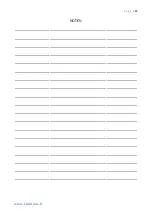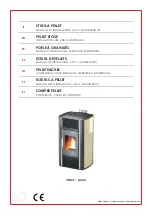
P a g e
|
9
www.ikikiuas.fi
4.
VENTILATION AND COMPENSATION AIR
Careful planning of the sauna room’s ventilation is necessary to ensure the stove gets enough air
to burn cleanly and the bathers get fresh air for breathing. Good ventilation is also required to dry
the sauna room properly after bathing.
The air that feeds the fire must be led in from outside the heating space (room), using a pipe
equipped with a 50-100 mm grate and a disc valve. Fresh air should be directed towards the stove
with, for example, a 100 mm pipe.
Inside the sauna the fresh air is led into the sauna through an air vent in the door or a gap
underneath the door. Sufficient flow of fresh air to the washing /changing room must also be
ensured. Air should be allowed to flow into the sauna quite freely during bathing and drying of the
room. Make sure the air inlets do not get obstructed.
Exhaust air is led out of the sauna preferably through a hole equipped with a disc valve and an
adjustable grid, placed between the lower and upper benches. The exhaust air should flow
through a metal channel inside the wall and to exit just below the roof on the outer wall. The
exhaust vent can also be in the ceiling or near the ceiling on the wall opposite the stove.
With machine assisted ventilation, the circulation of air and ventilation of the room is more
efficient. The air flow principles and intake and exhaust vent locations remain the same.
The use of chimney fans is not recommended with wood-burning sauna stoves. The high
temperatures of the combustion gases may break the ventilator. If there is more than one furnace
in use, the combustion gases from each furnace must be directed to a separate exhaust vent. For
example, using a cauldron and a stove requires a 2-passage chimney. The air inlets must be
measured as per situation (two furnaces, adjustable vents, etc.).






































